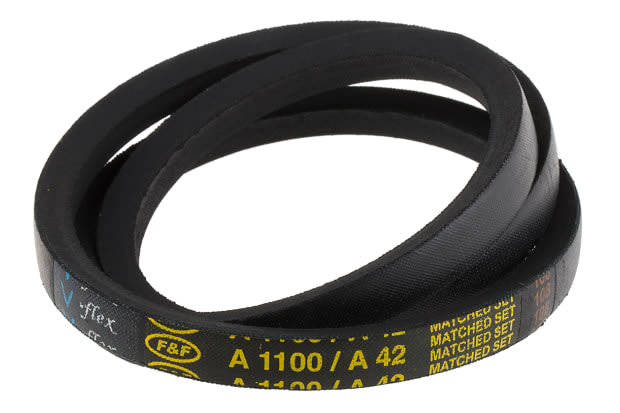- Published 1 Feb 2023
- Last Modified 29 Aug 2023
- 5 min
A Complete Guide to Drive Belts
Our guide is designed to help you explore drive belts - the different types, their uses, and how they work.

Read on to discover all you need to know about drive belts in our handy guide.
What is a Drive Belt?
A drive belt is a flexible loop that is used to connect multiple pulleys within a mechanical system. They are typically made from flexible, durable materials like rubber or various polymers which can withstand high tensile stress.
Drive belts are used for continuous power transmission. They are fitted on the exterior of the belt pulley and transfer power from the cam or crankshaft to other systems or accessories within the system. Drive belts are advantageous due to their simplicity, ease of installation/removal, and low cost - both purchase and maintenance costs.
They may also be referred to as wedge belts or serpentine belts.
Drive Belt Uses

Uses of drive belts include transferring power in the following industries and applications:
- Automotive
- Water pumps
- Air compressors
- Air conditioning
- Manufacturing
- Conveyors
How Do Drive Belts Work?
Drive belts operate using the force of friction to transfer power within the system. When a drive belt is installed, tension is applied. The tension then creates friction between the belt and the pulleys where it has been installed.
The crankshaft turns and transfers power to the camshaft, via a timing belt. This provides power to the drive belt via the camshaft, in turn, and causes the drive belt to move due to friction between it and the crank pulley. Lastly, friction between the belt and any accessory pulleys then causes them to rotate.
It should be noted that drive belts don’t last forever. Due to their composition, the rubber wears out through use and will typically degrade with time even if it has been reinforced using steel fibres. If a belt is worn, cracked, or otherwise damaged, it should be replaced as soon as possible to avoid downtime or damage to other components within the system.
How Do V Belts Work?
V belts work in a different way to drive belts. Whereas flat drive belts rely on friction, V belts feature sidewalls which slot into matching grooves on the system. This provides greater stability and surface area.
As a V belt operates, the tension force pushes the sides of the belt into the grooves. This increases frictional forces, which means higher loads can be transmitted using these belts as opposed to flat belts.
Drive Belt Types
Drive Belt Profiles
Belts are available in several industry-standard profiles. The profile is essentially the two-dimensional cross-section of the belt - its shape in a flat position when viewed from the side. The main profile types include:
Drive Belt Sizes
How to Measure Drive Belts
All V belts should be measured across the depth of the belt and the top, thick section. To measure a V belt correctly, this means that you would measure the widest part of the belt (the thickest section), and then measure from the widest to the narrowest parts of the belt.
It should also be noted that the different types, or sections, of V belts are measured slightly differently according to their length:
Section | Width | Depth | Internal/External Measurement |
|---|---|---|---|
| Z | 10mm | 6mm | Internal |
| A | 13mm | 8mm | Internal |
| B | 17mm | 11mm | Internal |
| C | 22mm | 14mm | Internal |
| D | 32mm | 19mm | Internal |
| E | 40mm | 25mm | Internal |
| SPZ | 9.7mm | 8mm | External |
| SPA | 12.7mm | 10mm | External |
| SPB | 17mm | 13mm | External |
| SPC | 22mm | 18mm | External |
| XPZ | 9.7mm | 8mm | External |
| XPA | 12.7mm | 10mm | External |
| XPB | 16.3mm | 13mm | External |
| XPC | 22mm | 18mm | External |
This also includes toothed cog-section V belts, which are denoted by an X. These cogs enable the belt to fit at tighter angles than a non-toothed belt.
Drive Belt Length Calculator
Determining the length of the belt you require can be challenging, but it’s important to ensure the belt is the correct length so the system runs smoothly and efficiently.
The following formula can be used to calculate the required length for a V belt:

This formula requires you to know the centre distance (C) and pulley diameters (where (d) is the diameter of the smaller pulley, and (D) is the diameter of the larger pulley). Therefore, if you know the pulley diameters and the distance between their centre points, you can use this formula to calculate the correct belt length you require.
What is the Difference Between Drive Belts and Timing Belts?
Though they may initially seem similar, timing belts are an alternate type of specialised belt. They are mainly used to transmit power inside systems.
One of the key differences between drive belts and timing belts lies in the function of the belt. Drive belts power the system or engine where they are installed, driving accessories such as alternators, air conditioners, water pumps, or power steering pumps. By contrast, timing belts are designed to connect and synchronise the movement of the camshaft and crankshaft. They are key components within engines for this reason.


